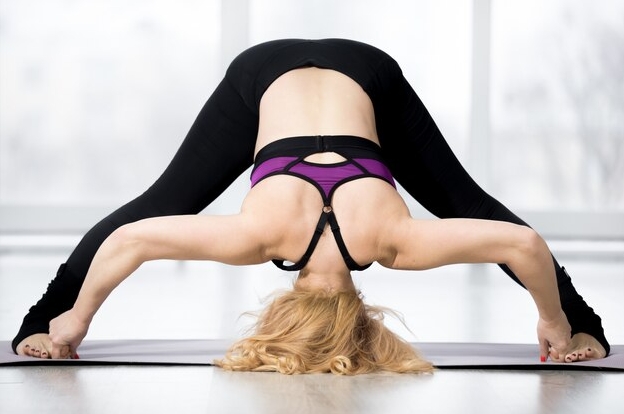10 de June de 2025
Standing Straddle: Exercise Guide, Tips and Benefits
The standing straddle stretch is a foundational flexibility movement that targets the hamstrings, adductors, and lower back. Commonly used in warm-ups, cooldowns, and mobility routines, it’s a simple yet powerful exercise for improving flexibility, posture, and circulation. Whether you’re a beginner working on basic mobility or an athlete enhancing your performance, the standing straddle is a valuable addition to your training routine.
What Is the Standing Straddle Stretch?
The standing straddle is a static stretch performed by standing with the feet wide apart and hinging forward at the hips to reach toward the floor or ankles. The position emphasizes a deep stretch along the inner thighs, hamstrings, and spine. It’s often used in yoga, dance, martial arts, and athletic training due to its benefits for flexibility and muscular balance.
It’s also a useful tool for managing fatigue and maintaining lower-body mobility between high-intensity training sessions.
How to Do a Standing Straddle Properly
- Stand tall with your feet 3–4 feet apart—wider than shoulder-width.
- Point your toes slightly forward or out at a 10–15° angle for comfort.
- Hinge at the hips and slowly fold forward, keeping your back flat as long as possible.
- Let your arms hang down or place your hands on the floor, shins, or ankles.
- Relax your head and neck to deepen the stretch.
- Hold for 20–60 seconds, breathing deeply.
Tip: Keep a slight bend in the knees if your hamstrings are tight or if you feel tension in your lower back.

Muscles Worked by the Standing Straddle
- Hamstrings: Primary stretch target, especially when reaching downward.
- Adductors (inner thighs): Stretched due to the wide stance.
- Glutes and lower back: Help maintain balance and control.
- Calves: Gently engaged as you reach toward the floor.
Benefits of the Standing Straddle Stretch
- Improved Flexibility: Increases range of motion in the hips and hamstrings.
- Better Posture: Releases tension in the spine and promotes upright alignment.
- Circulation Boost: Encourages blood flow through the lower body.
- Reduced Muscle Tension: Helps alleviate tightness after intense training.
- Injury Prevention: Supports joint mobility and muscular balance.
- Fatigue Management: Useful in deload phases or as an active recovery strategy to avoid overloading while maintaining movement quality. Learn more about training fatigue.
Common Mistakes to Avoid
- Rounding the Lower Back: Focus on hinging from the hips rather than collapsing forward.
- Forcing the Stretch: Avoid bouncing or pushing aggressively into the position.
- Feet Too Narrow or Wide: A stance that’s too narrow limits the stretch; too wide may strain the groin.
- Locked Knees: Slight knee bend helps avoid stress on joints and lower back.
Variations of the Standing Straddle Stretch
- Standing Straddle with Side Bend: Reach one arm over to the opposite side for a lateral stretch.
- Straddle Fold with Arms Behind Back: Clasp hands behind your back and fold forward to open the chest.
- Standing Straddle Twist: Place one hand on the floor and twist the torso to open the shoulders.
- Straddle to Toe Reach: Shift your weight side-to-side, reaching one hand toward the opposite foot.
These variations help engage the core, improve spinal mobility, and target multiple muscle groups. You can also use these variations as part of a complete strength and conditioning program to enhance flexibility and recovery.
How to Include Standing Straddle in Your S&C Workout
The standing straddle is ideal during cooldowns, mobility sessions, or active recovery days. Hold the stretch for 30–60 seconds and repeat for 2–3 rounds. Pair with dynamic hamstring movements or glute bridges to create a well-rounded flexibility block. It also complements exercises like squats and deadlifts by maintaining lower-body mobility.
Want to take your recovery strategy to the next level? Integrating static stretching like this into a structured program helps manage fatigue accumulation and supports consistent performance over time. Learn how to balance your sessions effectively with these strength and conditioning principles.

FAQs About Standing Straddle
What are the benefits of standing straddle stretch?
It improves hamstring and hip flexibility, enhances posture, supports spinal alignment, and reduces tension in the lower body.
How to do a standing straddle?
Stand with your feet wide, hinge at the hips, and fold forward while keeping your back flat. Let your arms hang down and hold the stretch while breathing deeply.
What does standing straddle mean?
It refers to a standing position where the legs are spread wide apart, typically used to perform a forward fold stretch targeting the inner thighs and hamstrings.
The standing straddle is a fundamental flexibility exercise with wide-reaching benefits for movement, performance, and recovery. Add it to your routine to unlock greater lower-body mobility, reduce stiffness, and support long-term joint health. It’s a smart complement to any structured strength and conditioning program and helps manage fatigue between heavy lifts or high-volume sessions.
